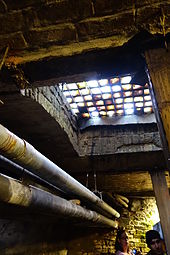User:Abihello6/Seattle Underground
This article needs additional citations for verification. (August 2007) |

The Seattle Underground is a network of underground passageways and basements in the Pioneer Square neighborhood of Seattle, Washington, United States. They were located at ground level when the city was built in the mid-19th century but fell into disuse after the streets were elevated. In recent decades they have become a tourist attraction, with guided tours taking place around the area.
History[edit]


After the Great Seattle Fire of June 6, 1889,[1][2][3][4] new construction was required to be of masonry and the town's streets were regraded one to two stories higher. Pioneer Square had originally been built mostly on filled-in tidelands and often flooded. The new street level also kept sewers draining into Elliott Bay from backing up at high tide.
For the regrade, the streets were lined with concrete walls that formed narrow alleyways between the walls and the buildings on both sides of the street, with a wide "alley" where the street was. The naturally steep hillsides were used and, through a series of sluices, material was washed into the wide "alleys", by raising the streets to the desired new level, generally 12 feet (3.7 m) higher than before, in some places nearly 30 feet (9.1 m).
At first, pedestrians climbed ladders to go between street level and the sidewalks in front of the building entrances. Brick archways were constructed next to the road surface, above the submerged sidewalks. Pavement lights (a form of walk-on skylight with small panes of clear glass which later became amethyst-colored) were installed over the gap from the raised street and the building, creating the area now called the Seattle Underground.

When they reconstructed their buildings, merchants and landlords knew that the ground floor would eventually be underground and the next floor up would be the new ground floor, so there is very little decoration on the doors and windows of the original ground floor, but extensive decoration on the new ground floor.
Once the new sidewalks were complete, building owners moved their businesses to the new ground floor, although merchants carried on business in the lowest floors of buildings that survived the fire, and pedestrians continued to use the underground sidewalks lit by the pavement lights (still seen on some streets) embedded in the grade-level sidewalk above.
In 1907, the city condemned the Underground for fear of bubonic plague, two years before the 1909 World Fair in Seattle (Alaska-Yukon-Pacific Exposition). The basements were left to deteriorate or were used as storage. Some became illegal flophouses for the homeless, gambling halls, speakeasies, and opium dens.
The Seattle Underground Tours[edit]
Only a small portion of the Seattle Underground has been restored and made safe and accessible to the public on guided tours. In 1965, local citizen Bill Speidel established "Bill Speidel's Underground Tour", which operates to this day.
The tunnels are what is left of the old city after The Great Seattle fires of 1889. The site contains remnants of artifacts and shops, as well as multiple tunnel entrances. The tour is found at the base of the Pioneer Building in Pioneer Square[5]. Bill Speidel began tour project of the Seattle Underground in 1954[6]. Speidel, who was previously a reporter at the Seattle Times began uncovering parts of the Seattle Underground by hiring teenagers from local high schools.[7]
The project collected significant media attention as a result of Speidel's findings in the Underground giving his discoveries to the local newspapers[6]. The Seattle Underground Tours were opened to the public in 1965, following "Know your Seattle Day". In May 1970, the Seattle City Council made Pioneer Square a Historic District following 100,000 petitions to keep Historic Landmarks such as the Seattle Underground Tour[6]. Aside from views of the past, the underground tour is known for the tour guides who tell the story of Seattle's past[7].
Other tours, like Beneath the Streets, seek to differentiate themselves from the Speidel's original tour by incorporating Native Tribal members into the discussion of Seattle's history[8]. Beneath the Streets is a new tour that became available to the public in 2013 and explores underground areas not available in Speidel's tour[8].
References[edit]
- ^ "Seattle in Ashes". Los Angeles Daily Herald. June 7, 1889. p. 5.
- ^ Hugh McGough, "The Great Seattle Fire—Don't Blame Jimmie McGough"
- ^ "The P-I error that changed Seattle history". Seattle Post-Intelligencer. July 22, 2011.
- ^ "The Seattle Fire". Los Angeles Daily Herald. June 8, 1889. p. 5.
- ^ Brian Christopher., Shaklee (2004). "The museum of the city of Seattle". ProQuest Dissertation Publishing: 26 – via ProQuest.
- ^ a b c Bill Speidel's Underground Tour. "A Little History". Bill Speidel's Underground Tour.
{{cite web}}: CS1 maint: url-status (link) Cite error: The named reference ":0" was defined multiple times with different content (see the help page). - ^ a b Lyke, M.L. (2001-01-07). "The Inside Story: Going Underground in Seattle". The Washington Post. p. 3. Retrieved 2022-01-26.
- ^ a b "Beneath the Streets: About". Beneath the Streets. 2021-01-26. Retrieved 2022-01-26.
See also[edit]
- Catacombs of Paris
- Catacombs of Rome
- Edinburgh Vaults
- Mary King's Close
- Manchester Cathedral Steps
- Raising of Chicago
- Shanghai tunnels (less commonly known as the Portland Underground, in Portland, Oregon)
- Underground Atlanta
- Underground City, Montreal, modern construction of interconnected office buildings, hotels, shopping centres and other venues in Montreal's CBD
- Underground City (underground features in cities around the world)
References[edit]
Cheese
Further reading[edit]
- Speidel, Bill (1978). Doc Maynard, The Man Who Invented Seattle. Nettle Creek. ISBN 0-914890-02-6.
- Speidel, Bill (1990). Sons of the Profits. Nettle Creek. ISBN 0-914890-06-9.
External links[edit]
 Media related to Abihello6/Seattle Underground at Wikimedia Commons
Media related to Abihello6/Seattle Underground at Wikimedia Commons- Mashable: 1905-1930 The Seattle Regrade
Underground Category:Tourist attractions in Washington (state) Category:Underground cities
